1 Photo Will Not Be Uploaded Because It Was Not in the Correct Format (Jpeg/jpg)
Website owners see image files all the time. While you don't have to exist an paradigm expert to edit and upload images to a website, yous should familiarize yourself with common file formats such as JPEG.Or is it JPG?
In this article, I'll present a JPG vs JPEG showdown then you sympathise the differences, too as other details that will help you upload the all-time images possible to your website for the ultimate user experience. If your looking for an in-depth guide about the modern .webp file format, we've got yous covered too.
Prepare? Let's get started!
What is JPEG?
As a website owner working with images, yous have nigh likely seen the file format JPEG at some point during your editing and uploading adventures.
But did you know that the term JPEG is actually a reference for three dissimilar things?
Well, it is and we're hither to explain all of them:
i. JPEG Lossy Compression
When you upload images to your website, it's important you take care not to negatively affect your site's speed and performance by using big images that waste resources and take forever to load on the frontend of your site. In fact, all website owners should optimize their images in some way to reduce the file sizes of their images and preserve loading times and the user feel.
That'south where JPEG comes in handy. JPEG is a lossy compression method used to ensure the digital images being used are as modest as possible and load rapidly when someone wants to view them.
Here are some things to remember about lossy compression:
- The file size of the image beingness compressed is permanently reduced by eliminating unnecessary (redundant) data from the image.
- Image quality does endure, though it's oft so slight the boilerplate site visitor tin can't tell.
- During the compression process, each pixel is compared to pixels surrounding it in a ratio ranging from two:1 all the way to 100:1 (any pixels that are the same every bit the original are then deleted every bit they are deemed redundant).
- JPEG lossy pinch is unremarkably used for photographs and complex still images.
- When you shrink an image using lossy compression, you make up one's mind the file size and epitome quality trade-off (e.k., smaller files = worse image quality).
- The more editing and saving of a single image you practice, the worse the quality of the image volition be.
If yous're more experienced in editing images using lossy compression, there is a take chances y'all can save the image quality while reducing its file size by working with RAW JPEG images, making edits, and saving the image in one case.
If you lot don't want to perform JPEG lossy compression on your site's images, there's always the alternative: lossless compression.
Lossless compression saves your images in an entirely different format (usually PNG). While the image quality is never sacrificed considering no information is eliminated, know that with lossless pinch the final file size of your epitome will ever exist bigger than with lossy compression. This may result in slower page loading times.
2. Articulation Photographic Experts Grouping (JPEG)
JPEG stands for the Articulation Photographic Experts Grouping, which is the name of the sub-committee that helped create the JPEG standard, as well equally other notwithstanding film coding standards nether the broader group chosen ISO.
The first JPEG standard was issued in 1992 past ISO (International Organization for Standardization). ISO is responsible for creating documents that "…provide requirements, specifications, guidelines or characteristics that can be used consistently to ensure that materials, products, processes, and services are fit for their purpose."
ISO sets the standards for many things, including digital images, in an try to provide users and consumers with the highest quality products and services.

This international system is a voluntary grouping of people with members from over 164 countries, making it the world's largest developer of standards.
three. JPEG equally a File Format
The terminal way the term JPEG is used is when referencing a file format name or a manner to store and save digital images. This is probably the way y'all're well-nigh used to seeing JPEG because this is one of the file format choices you accept when you save an image after editing it.
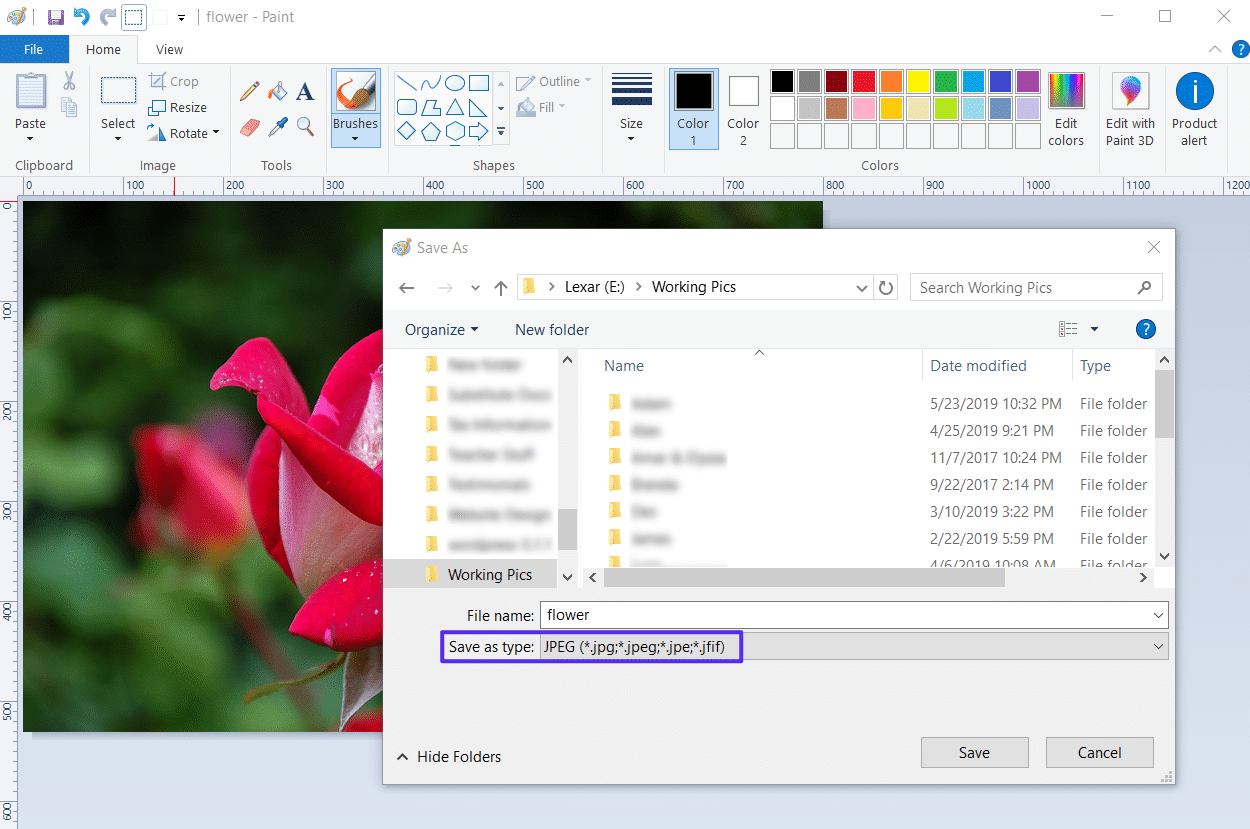
Hither are some fun facts about the .jpeg file format:
- Most common paradigm file format used past digital cameras and other epitome capturing devices.
- Supports xvi,777,216 colors, which are produced using 8 $.25 of each in the RGB color model.
- Tin display more than 16 million colors at once, making the color scheme and dissimilarity resolution most perfect.
- Supports a maximum size of 65,535 x 65,535 pixels.
- Reduces the size of an image past about l-75% (because of lossy compression) when saved
Lastly, this type of file format is non ideal for images with sharp edges because the colors blend together more if it were saved as a .png, which display private pixels as a combination.
So, at present let'southward check out what JPG is.
What is JPG?
What in the globe is JPG in comparison to JPEG?

Well, when information technology comes to .jpeg vs .jpg, the truth is at that place is no divergence between the two except the number of characters.
Crazy right? Permit united states explain.
The term JPG exists because the earlier versions of Windows operating systems. Specifically, the MS-DOS 8.iii and Fat-sixteen file systems had a maximum three-letter limit when it came to file names, dissimilar the UNIX-like operating systems like Mac or Linux, which didn't have this limit.
So, on Mac or Linux systems, images saved as JPEGs used the file extension .jpeg. Merely when it came to saving those same types of images using Windows, the file extension had to be shortened to .jpg then information technology didn't exceed the 3-letter limit.
Nowadays, Windows operating systems accept 3- or 4-letter file extensions such as .jpeg or .jpg. But since so many people have been using Windows for so long, and are used to saving their images equally JPGs, they haven't stopped. Because of this, photo editing software such as Adobe Photoshop and GIMP save all JPEG images past default to the .jpg file extension on both Windows and Macs to avoid confusion.
JPG vs JPEG: Similarities Between the Two
Okay, and so you know that .jpeg and .jpg files are the same exact thing. But just to bulldoze that point domicile, and help you remember it long into the future, we're going to look at the similarities of JPEG and JPG images.
one. Both Are Raster Images (Not Vector Images)
Figurer images tin be created as raster or vector images. And since JPEGs are raster images, so are JPGs.
Raster graphics are bitmaps of images. A bitmap is a grid of individual pixels that when combined create an entire image. In other words, raster images are a drove of endless tiny squares (or pixels) of color that are each coded in a specific hue or shade that when put together create a whole image that makes sense to await at.
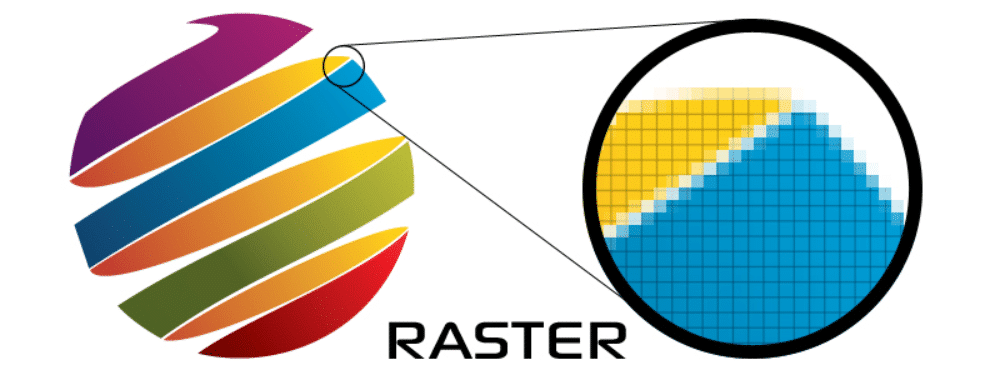
Hither's more data virtually raster images to help you lot better understand:
- All-time used for non-lined images such as photographs, scanned artwork, or detailed graphics.
- They have subtle hue or shade gradations and very undefined lines and shapes.
- Due to their pixel-based nature, they endure quality bug when diddled up in size (they get jagged and expose individual pixels).
- They are defined and displayed at ane specific resolution, which is measured in dots per inch (dpi).
- The college the dpi, the improve the resolution and visual entreatment of the image.
- Common raster file formats include: TIFF, JPEG, GIF, PCX and BMP files.
- Raster images are the Spider web standard, meaning they are preferred for all images found on the internet.
Again, JPEGs and JPGs are not vector images.
Subscribe Now
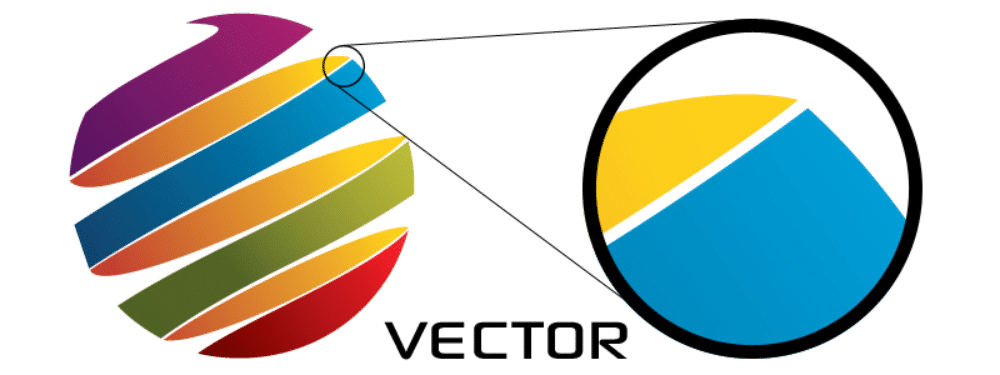
Here'due south some information about vector images and so y'all can understand the difference:
- Images are based on mathematical formulas that define geometric shapes like polygons, lines, curves, circles, and rectangles.
- Perfect for straight-edged images like line art.
- Considering at that place are no colour gradations, they piece of work well for flat, uniformly colored images.
- Include popular graphics such as logos, letterhead, and fonts.
- Scale up or down without any quality degradation because they don't rely on pixels to make the prototype whole.
2. Both Terms Mean the Same Affair
Remember when we discussed the term JPEG and how it stood for the Joint Photographic Experts Group? Well, y'all guessed it; both JPEG and JPG are abbreviations for that same ISO sub-committee.
3. Both Are Used for the Same Paradigm Types
Considering they are raster images, and non vectors, both .jpeg and .jpg file formats are all-time used for digital photography. Digital photographs have extensive color gradations that appear seamless when saved equally raster JPEG/JPG images. This ways your site visitors will always encounter a beautiful photo if it'southward saved every bit a .jpeg/.jpg and uploaded to your website.
Acquire more than nearly epitome file types and their impact on your website.
4. Both Lose Some Quality When Saved
Since the .jpeg vs .jpg comparing is nix (because they are the aforementioned exact matter), it makes sense that the compression method used on each file format — lossy compression— results in some loss of image quality as the file size of the image decreases.
In addition, this means that no matter what file extension you use (either .jpeg or .jpg), your image's file size will be smaller than it was originally and consequence in faster loading times when uploaded onto your website and viewed by site visitors.
In the cease, JPEGs and JPGs are the same thing and serve a few main purposes: to reduce the file size of images for better web viewing and requite people an piece of cake fashion to compress their images upon saving and name the file using a common file extension that is recognized by many.
So ask yourself: JPG vs JPEG, which is improve? From there, don't think too hard because the respond is neither. They are the same and whichever one yous choose, is merely a matter of preference.
JPG vs JPEG 2000
If you've ever constitute yourself searching for information about JPEGs and JPGs, yous may have come up across the term JPEG 2000 and wondered what in the globe that was. After all, that's not an option in nigh prototype editing software.
JPEG 2000 was an image encoding system created past the Joint Photographic Experts Group in 2000 that was designed to be better than the JPEG standard already in place. In fact, it was designed to implement lossless compression on images using avant-garde compression techniques on a discrete wavelength transformation.
It offered people a manner to optimize their images and save them as JPEGs, without degrading the quality of the image.
Here are some of the about important features of JPEG 2000:
- Advanced Compression Techniques: different traditional JPEGs, JPEG 2000 was able to perform both lossy and lossless compression (even on a single image file).
- Progressive Decoding: enables site visitors to see a lower quality version of an image while the entire paradigm is still downloading in the background. As more data is downloaded, the image quality improves for the viewer.
- Higher Compression Ratios: when information technology comes to lossy compression, JPEG 2000 tin shrink an prototype from xx-200% more than JPEG, while maintaining the aforementioned paradigm quality when compared to a JPEG image of the same size.
In improver, JPEG 2000:
- Offers transparency preservation in images.
- Can describe bi-level, grayscale, palette-color, and full-color image data.
- Includes unlimited amounts of private or special-purpose information within metadata.
- Can handle larger image sizes (greater than 64K 10 64K pixels), with no tilting.
- Ultra-low latency, which is peculiarly useful for alive TV content.
- Scalability in both resolution and quality.
JPEG 2000 Limitations
Though JPEG 2000 has plenty of corking features and seems to be the next best coding standard for digital images, at that place are reasons why information technology is nonetheless non a popular file format for nigh people:
- No universal browser support (only supports Safari).
- Incompatible with JPEG (must encode a new standard and back up original JPEG).
- Encoding JPEG 2000 files is CPU intensive, which can strain servers and irksome things down.
- Many websites and cameras are not set to accept the format because it's not universally accepted.
Because of its limitations, you'll be hard-pressed to find the JPEG 2000 file format as an option while saving your digital images. And while it is arguably meliorate than JPEG, until information technology is universally accustomed, you'll likely run into a bunch of compatibility problems making your task harder equally a website owner than it needs to be.
Convert Image Files to JPG: Common Methods
There are plenty of ways to save your digital images as .jpg or .jpeg files. Allow's take a look at a few.
1. Windows Paint
If you have Windows, you can easily salvage whatever paradigm as a .jpeg or .jpg using Windows Paint. Just upload your paradigm to Windows Pigment, go to File > Relieve as, cull the file destination, proper noun your image, and select JPEG (*.jpg, *.jpeg, *.jpe, *.jfif) from the dropdown menu.
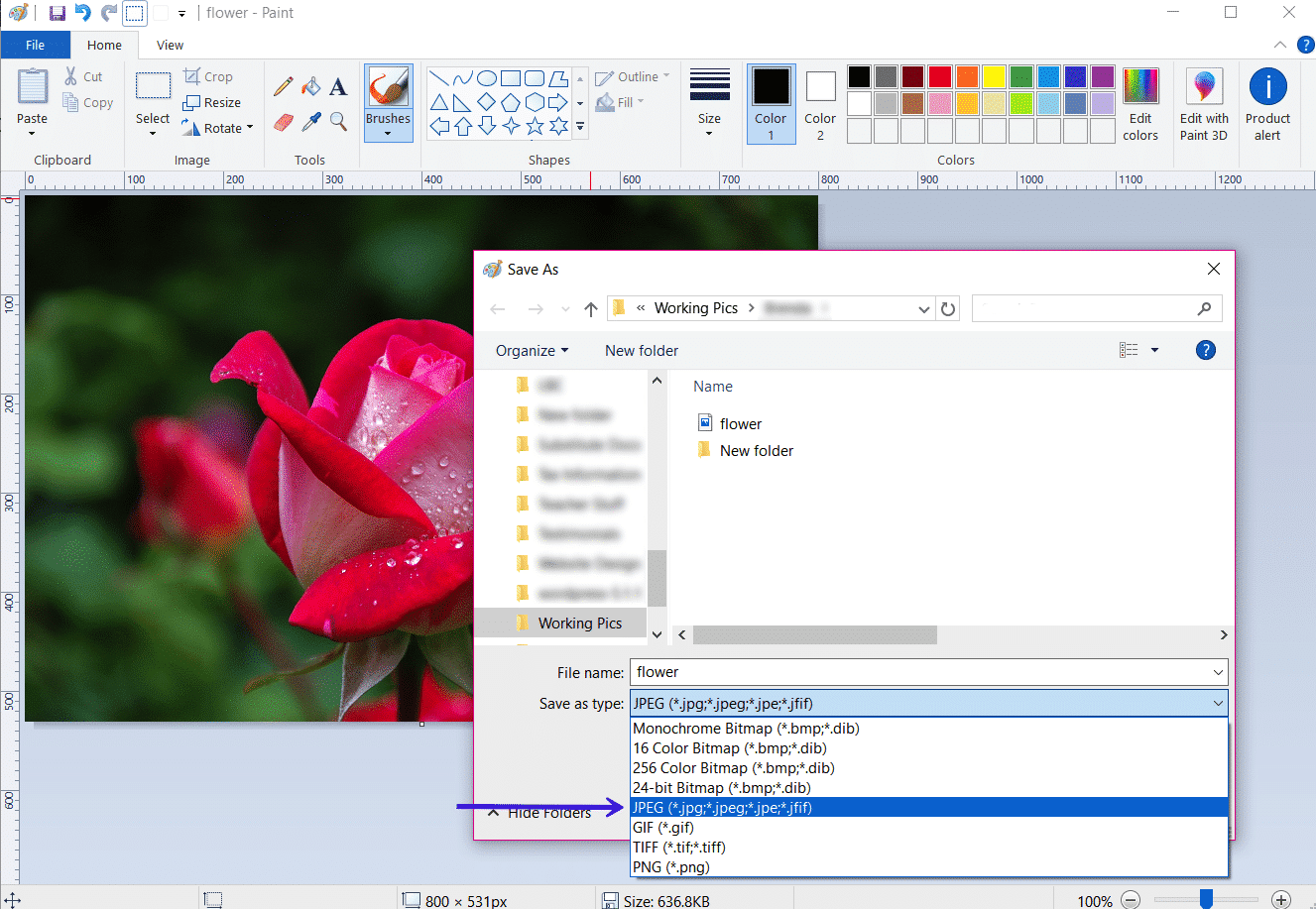
Then click Save.
2. Affinity Designer
Affinity Designer is much like other paradigm editing software such as Adobe Photoshop. To save an image equally a JPG using a software like this, offset by opening the application and uploading your image. Make any edits you desire and click File > Consign…. So, select the JPEG icon, choose the quality (best, high, medium, or low), and click Consign.
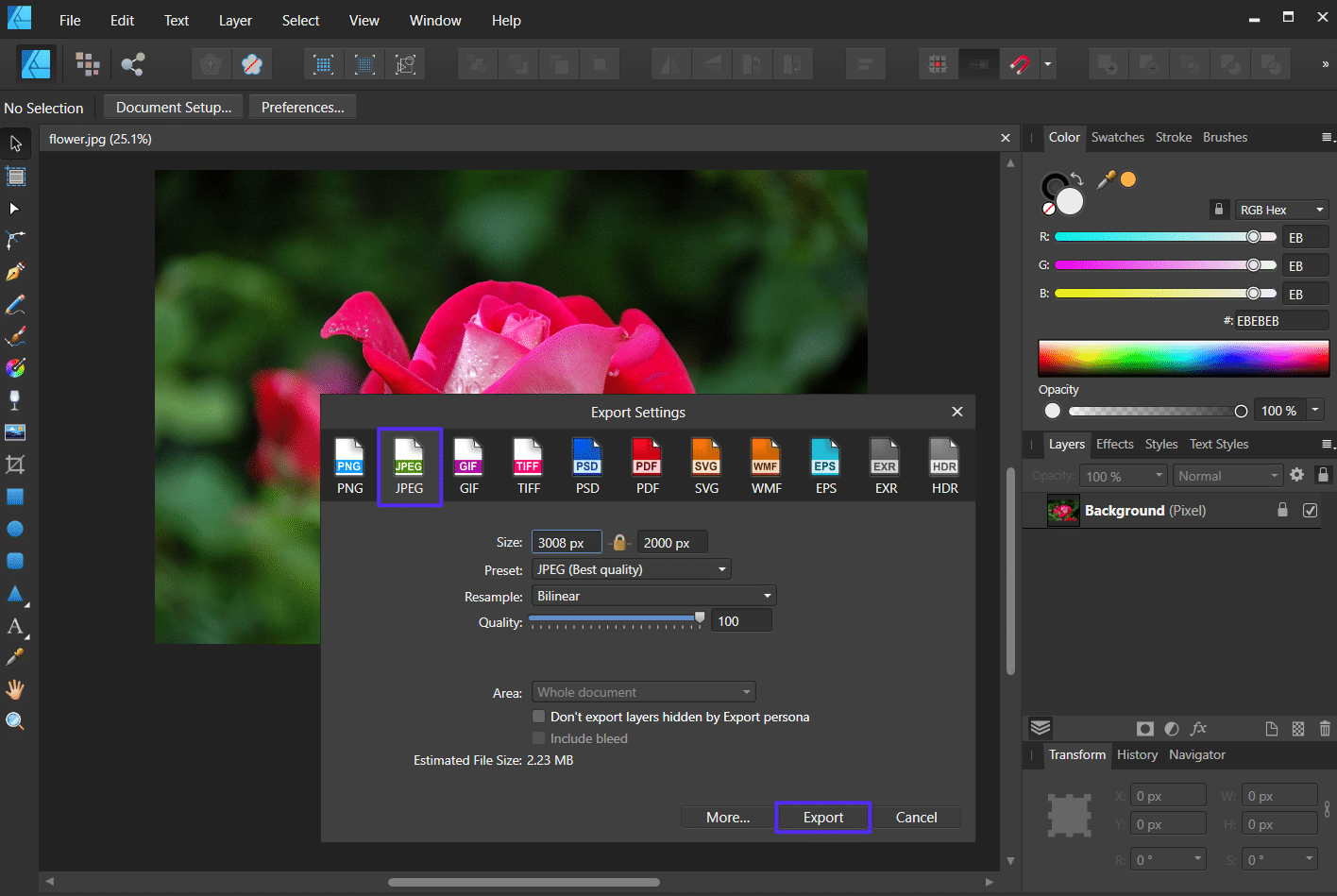
When you do, the Salve As dialog will open and so you tin can choose a file destination, name your image, and once more ensure that you lot are saving the file every bit a JPG.
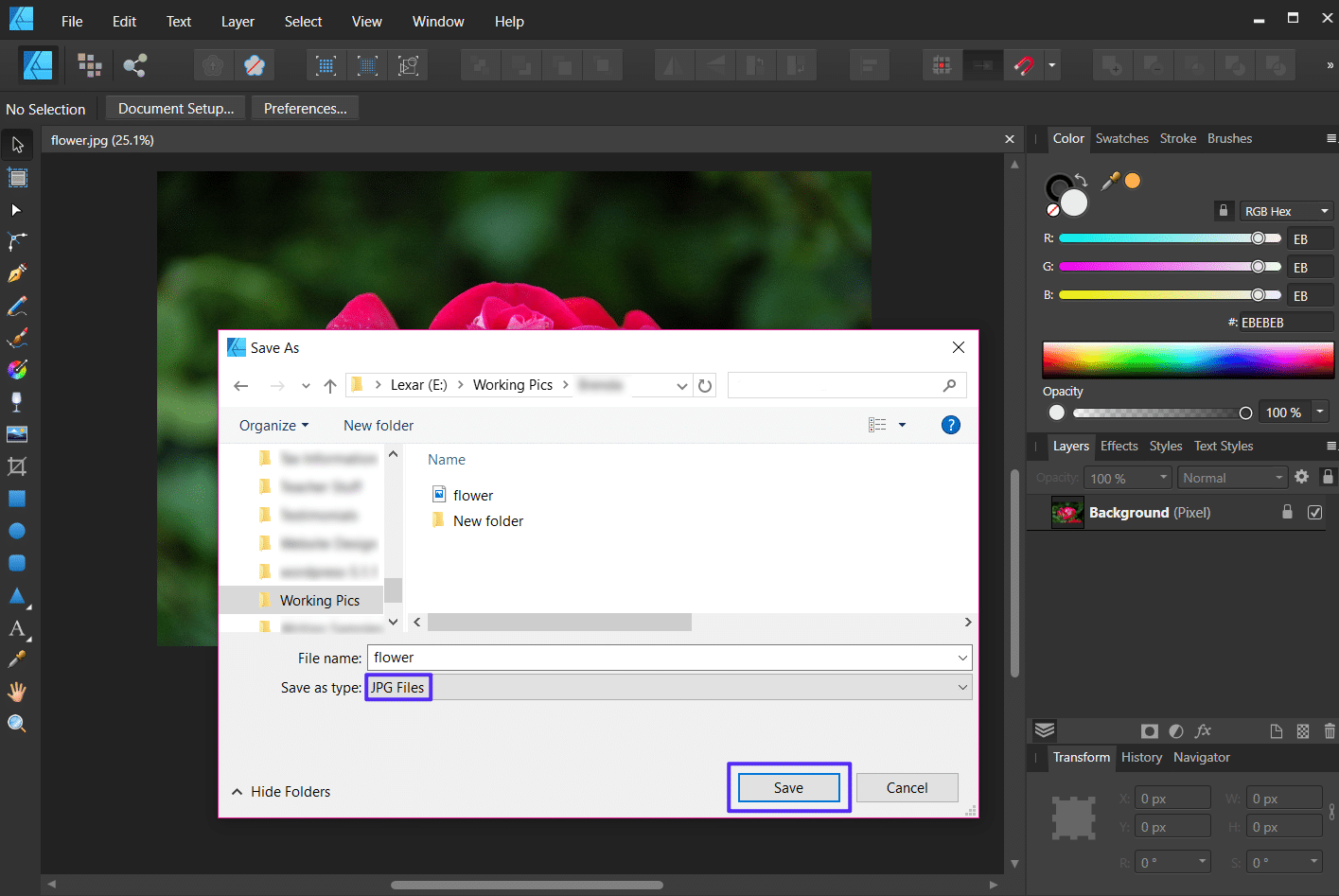
Click Relieve.
3. Online Converter Tool
If y'all want to convert images to JPG, there are many gratuitous online jpg converter tools to assist. For example, FileZigZag is a gratuitous online file converter that's simple to use. Just drag and drop your image file or upload information technology, cull the file type to convert the prototype into, enter an email address, and click Catechumen.
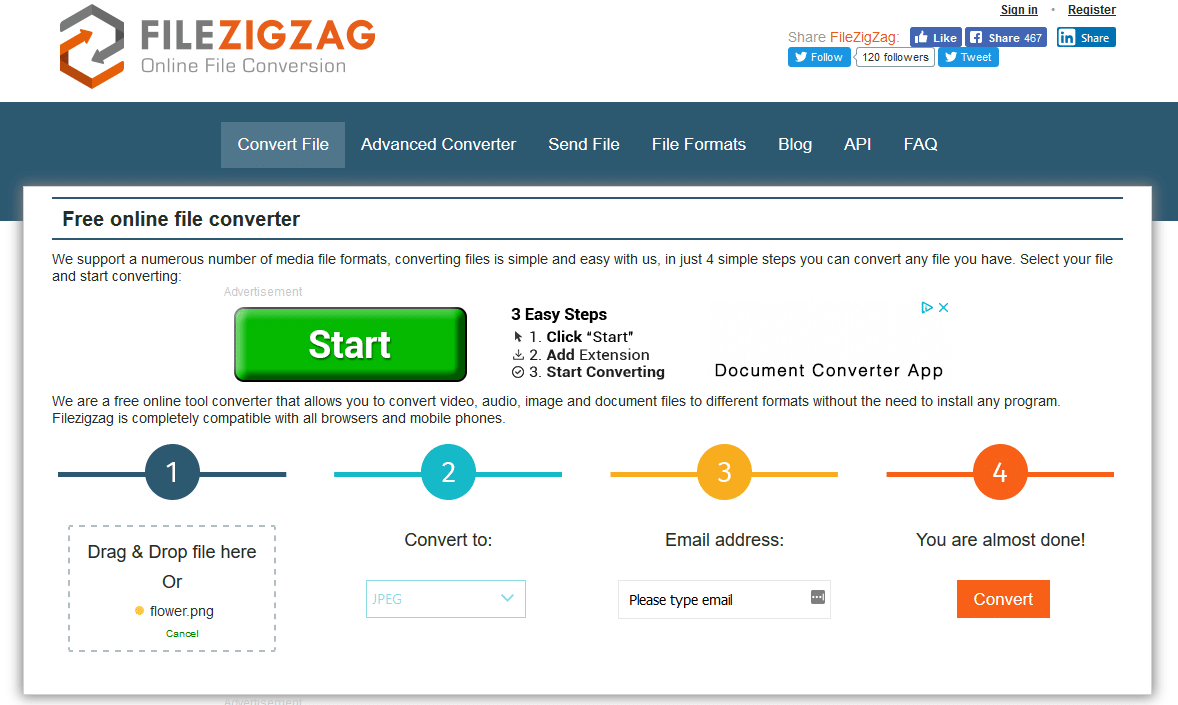
Of course, you may not want to hand over your email in exchange for converting your paradigm into a JPG. That'due south why we've rounded up some other gratis and premium solutions for you to check out:
- XnConvert: perfect for advanced image editors that need lots of prototype file formats, the ability to bulk convert, and apply Windows, Mac, or Linux.
- Zamzar: a free online tool for those with large images (up to 50MB) that want the option to have the end effect emailed or non.
- Adapter: a uncomplicated image converter that supports batch images and converts instantly and works on both macOS and Windows.
Of grade, these are simply some of the available options yous accept if you want to convert images to JPG.
Summary
JPG vs JPEG are the most common file extensions and pinch methods for those wanting to shop and save digital images. This is specially true for website owners that want to display visually appealing imagery and maintain an exceptional user experience.
Luckily for you, no matter whether you prefer .jpeg, .jpg or .webp file types, you're going to get the aforementioned outcome: cute images that load blazing fast for site visitors.
Save time, costs and maximize site performance with:
- Instant help from WordPress hosting experts, 24/7.
- Cloudflare Enterprise integration.
- Global audience reach with 29 data centers worldwide.
- Optimization with our built-in Application Functioning Monitoring.
All of that and much more, in one plan with no long-term contracts, assisted migrations, and a 30-day-money-dorsum-guarantee. Check out our plans or talk to sales to notice the plan that'south right for yous.
Source: https://kinsta.com/blog/jpg-vs-jpeg/
0 Response to "1 Photo Will Not Be Uploaded Because It Was Not in the Correct Format (Jpeg/jpg)"
Post a Comment